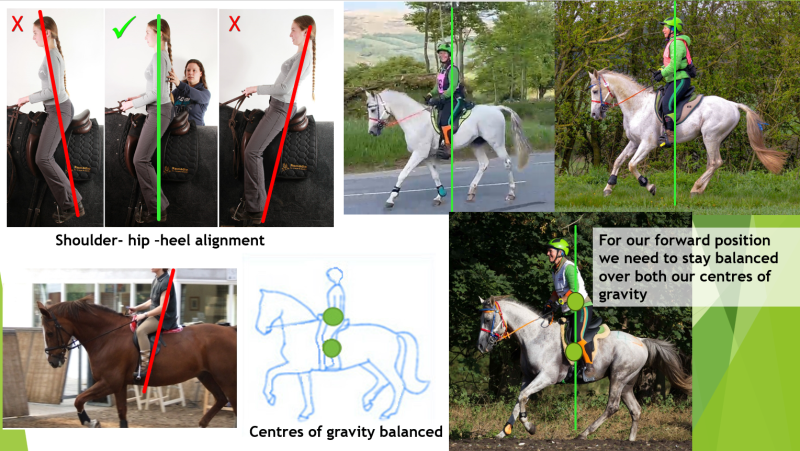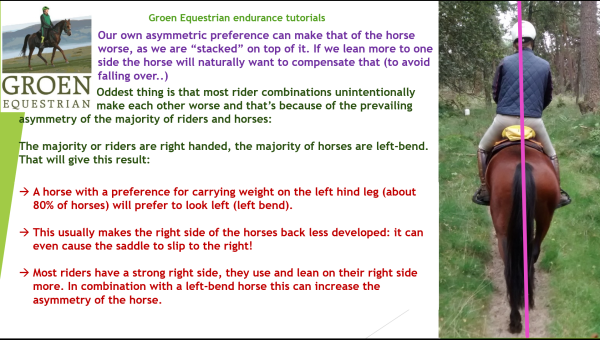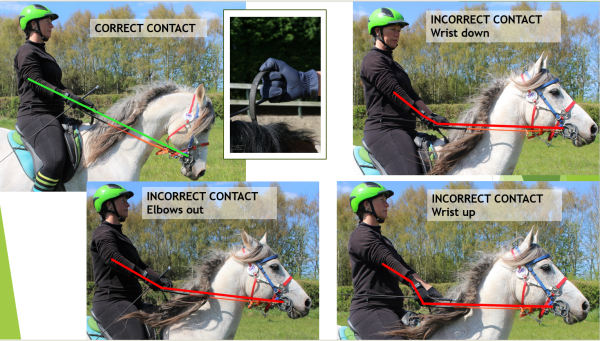EGB Magazine art7: Improve yourself to improve your horse
This is the third in a new series of articles in which we will investigate the quality aspect of training and how to maintain a healthy, sound, and happy equine athlete. The first article touched on the basics and "riding in the box," and in the second I gave you information, tips and exercises for the practical quality aspect of training
In this third article we will take a closer look at ourselves: the rider and how we can improve our riding an therefor the going of our horse.
Rider skills are super important for all equestrian sports, and whilst we are not judged on our skills by a judge like in dressage, or drop poles if we make a mistake like in show jumping, the many hours in the saddle mean that our horses are influenced by how they carry us for all this time. So it definitely pays off to see if you can check if you are supporting your horse as much as you can. The great thing is that some small adjustments in our position, focus and balance can make a big difference to our horse and can therefor improve our overall performance and potentially reduce injury. Let's go over some simple checks together.
The first thing to check is our balance, because we are "stacked" on top of the horse we can act like a lever: if we lean to far forward, back or to the left or right, we will cause our horse to have to adjust its own balance to accommodate more weight on the side we favour. A simple check is look at any footage from you from the side: how is your shoulder-hip-heel alignment? Is that a straight line so when you "take the horse away" you would land on your feet, or would you tip to your backside or on your nose. Once you have an idea of what is going on, you can try to improve that alignment a little, either on your own, or with some help of ride buddies and/or a coach. By sustaining an independent position we can avoid being too forward and getting the horse on the forehand, which can make it rush and put more pressure on forelimbs. Or when we sit to far back we will be behind the movement, slowing the horse down and causing it to use extra energy to move itself forward, creating strain on hocks and back.
Your balance left-to-right is also important, I would say even more so. It is very easy to unbalance our horse when we lean a little too much to one side, mostly in walk which is a lateral movement, but also in trot and canter because these are much faster gaits. Like us our horses have a preferred side, and this means they already have a tendency to use their preferred diagonal and canter lead. If we accumulate that by leaning a little more to one side it will be much harder to correct these asymmetries. Not only that but we will put more strain on the side of the body to which we lean to, as the horse needs to step "under" us to keep its balance. Again a coach, instructor or a ride buddy can help you with giving you feedback on your balance, and then it is up to you to correct yourself to help your horse move as effortlessly as possible.
Looking down is another very simple thing to correct: many of us like to see the ground our horse will travel on to make sure everything is safe. But when the highest part of our body is bent forward and down, the law of the lever will come into effect giving a lot more weight on the forehand. You can still see the ground using your peripheral vision but look ahead of you (and you can of course see the ground you will travel on and make even earlier adjustments to keep your horse safe)
Many of you might have been taught to grip with your knees, put your shoulders back and to put your heels down. Nowadays we know that this is detrimental for our position and our ability to move fluently with the horse. Let me quickly explain why: Our joints are our shock breakers and hinges, if we lock one we lose our ability to absorb the horses movement and we become rigid. Lets see what the old school riding instructors were actually teaching us:
Gripping with the knees: When the knee joint is locked because we grip onto the saddle we lose the ability to move knee, ankle and hip, fixing our position, often in a chair seat. Because we can't absorb the movement of the horse, it will feel more bouncy, which in turn will make us feel we have to grip more. We won't be able to adjust our pelvis, and this will make our rising trot less fluent, rocking back and forth when we should ideally stay over our centre of gravity (and that of our horse)
Shoulders back: many riders that have a tendency to lean forward will have heard this, but when we fix our shoulders back our arm becomes rigid, disabling our ability to keep a soft contact as we cannot move our arm forwards and back with the motion of the head. Bringing our shoulders back will also hollow our back, which makes using our core virtually impossible
Heels down: another often heard mantra, but when your heels are flexed to far down our ankle loses that vital ability to absorb movement and in turn will fixate the knee and hip which then leaves the whole leg immobile
Once learned it is very hard to change these habits, we need to actively remind ourselves time and time again to check and adjust, until a new neuromuscular pathway is developed.
And this brings me to another bad habit many of us have, especially as we spend so much time on our horse. Many of us have become a passive rider. We sit and are a passenger on our horse, we react when there is a sudden change. This passive rider also has a passive position: usually a little slumped, using the saddle and horse for support.
And our horse feel this, so they either become more alert but more often also switched of, not using their body correctly and not as aware of their surroundings as they should be. Try to become a more active rider, one that sits up, uses their core and is aware of the surroundings and their horse, be proactive instead of a passenger and you will feel that your horse will respond to this.
A correct contact on the reins will help with being an active rider, and communication with your horse will improve greatly as a wrong hand position can create a lot of white noise in our "conversations" and even mean that we are hard on the mouth when we do not want to. Soft shoulders and activated core muscles will help with creating a softer, better and more fluid contact.
It al sounds like hard work and a lot of things to remember, and for a while it will take some conscious effort to remind yourself and correct bad habits in order to create new. But just a simple thing like sitting more balanced will effectively improve your performance in endurance as it will take your horse less effort to do the distances, and less in risk of an injury
The last article in this series will deal with "Quality in competitive riding"




